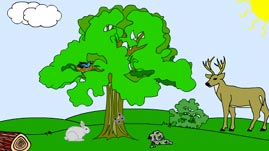Teachers' Domain - Digital Media for the Classroom and Professional Development
User: Preview

Source: University of Alberta and Bio-DiTRL
What are ecological systems, and what types of organisms live in these environments? This interactive activity adapted from the University of Alberta identifies the living and nonliving components of an animated ecosystem. Users are also invited to look at examples of mimicry, and identify which living things are producers and which are consumers. To help users complete the activity, key terms, including biotic and abiotic components, are defined.
Think of an ocean, a lake, and a puddle. They differ considerably in scale. Yet these three bodies of water qualify equally as ecosystems—short for ecological systems. All three contain living organisms that interact with each other and with the nonliving parts of their environment. Because no conceptual restrictions govern how large or small ecosystems can be, they are, in a sense, determined by the eye of the beholder.
Living organisms in an ecosystem, called biotic components, are often too small to be seen with a human eye. Examples include bacteria in soil, skin mites, and certain algae. Visible components include birds, mammals, insects, and trees. Nonliving things, such as air, sunlight, water, and rocks, are called abiotic components. Biotic components depend on their abiotic counterparts to meet their survival needs. For example, animals rely on air as a source of oxygen, plants need sunlight for photosynthesis, and all living things require water to sustain essential chemical processes.
The number and distribution of organisms in an ecosystem is limited by the availability of energy and the ability of the ecosystem to recycle matter. The sun is the source of energy in nearly every ecosystem and different species within an ecosystem do their part to help cycle energy through it. Some species, known as producers, convert sunlight into chemical energy through photosynthesis. Others, known as consumers, feed on producers (and other consumers). In this way, energy gets passed from organism to organism. Decomposers and scavengers are the primary recyclers. By feeding on dead plant and animal life, they break down organic waste material and return essential elements, such as nitrogen and phosphorous, to the ecosystem. The feeding relationships among living things in an ecosystem can be portrayed in complex models called food webs.
Organisms both cooperate and compete in ecosystems. The interrelationships and interdependencies that develop between organisms may sustain stable ecosystems for thousands of years. New elements, whether abiotic or biotic, tend to disrupt ecosystems when they are introduced. In some cases, a new, stable state is realized once species have adapted to the changed conditions. In others, however, change can lead to ecological collapse and the death of many species. As human populations grow, for instance, and their consumption of food, water, and other materials increases, the ecosystems that provide for these needs are, at the very least, being stressed—and, in some cases, they are being destroyed.
 Loading Standards
Loading Standards Teachers' Domain is proud to be a Pathways portal to the National Science Digital Library.
Teachers' Domain is proud to be a Pathways portal to the National Science Digital Library.
